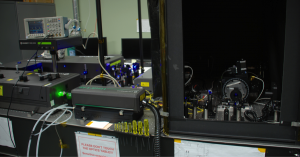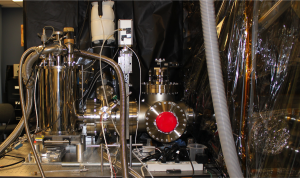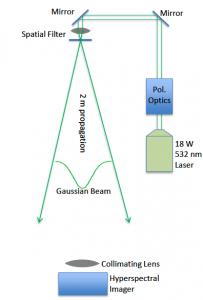
Spectral Solar Irradiance Record
The Spectral Irradiance Monitor (SIM) instrument onboard the SOlar Radiation and climate Experiment (SORCE) measures the solar spectral irradiance from 200 to 2700 nm and prvovides the first continuous measurements of spectral solar irradiance (SSI) between 400 and 2400 nm. The clouds, aerosols, surface, and atmospheric composition comprising Earth scatter and absorb the incoming solar energy in wavelength-dependent ways, making accurate knowledge of the spectral behavior of the Sun at these same wavelengths critically important for climate research. For this reason, the SIM instrument designed for the Total Solar Irradiance Sensor (TSIS) mission has improvements over SORCE SIM in terms of absolute accuracy and long-term stability.

Spectral Radiometer Facility (SRF-SIRCUS)
The improvements in absolute accuracy are achieved through spectral pre-launch calibrations of the radiometric response of TSIS SIM at the unit and instrument level and are tied to a NIST SI-traceable standard. These calibrations are performed at LASP’s Spectral Radiometer Facility (SRF), completed in 2012, using the NIST Spectral Irradiance and Radiance responsivity Calibrations using Uniform Sources (SIRCUS) tunable-lasers. Levels of absolute radiometric accuracy uncertainty achieved reach 0.2% across the spectrum.
The LASP Spectral Radiometer Facility (SRF):
- Performs spectral irradiance calibrations at power levels typical of Solar irradiance values and under flight-like vacuum conditions over 210-2400 nm (extendable to > 3000 nm).
- Allows for quantitative measurements of the spectral response functions (i.e. spectral slit function),
- Provides an absolute calibration tied directly to a NIST L-1 Cryogenic radiometer (traceable to the NIST Primary Optical Watt Radiometer – POWR),
- Allow for calibrations of channel to channel boresight alignments, and
- Allows for calibrations of pointing and FOV mapping effects on measured signal.
The Role of the SRF in Calibration and Performance Characterization of Spectral Imagers

The Spectral Radiometer Facility (SRF) has also been used in the calibration and performance characterization of spectral imagers.
The SRF was at the center of calibration for a hyperspectral imager developed for the NASA Earth Science Technology Office 2007 Instrument Incubator Project (IIP) called, A Hyperspectral Imager to Meet CLARREO Goals of High Absolute Accuracy and On-Orbit SI Traceability. For this IIP project, the calibration performed in the SRF addressed:
- the absolute accuracy,
- the attenuation methods,
- imaging performance, and
- spectral performance.
The SRF demonstrated the ability to validate these attenuation methods to < 0.2% and spectral and spatial performance to < 1% pixel uncertainty.
Achieving such levels of accuracy in calibrating spectral imagers are a result of the stable and uniform illumination produced in the SRF facility, at the power levels of the Sun and at typical Earth scenes. The uniform beams are generated via Gaussian beam expansion of the laser source through a 2m long vacuum chamber. The IIP instrument (and future instruments) to be calibrated sit at the far end of this chamber on a 4-axis gimbal.

